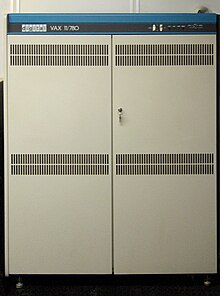DEC VAX
 |
|
| VAX-11/780 | |
| Manufacturer | Digital Equipment Corporation |
|---|---|
| Byte size | 8 bits (octet) |
| Address bus size | 32 bits |
| Peripheral bus | Unibus, Massbus, Q-Bus, XMI, VAXBI |
| Architecture | CISC, virtual memory |
| Operating systems | VAX/VMS, Ultrix, BSD UNIX, VAXELN |
| DEC VAX registers | ||||||||||||||||||||||||||||||||||||||||||||||||||||||||||||||||||||||||||||||||||||||||||||||||||||||||||||||||||||||||||||||||||||||||||||||||||||||||||||||||||||||||||||||||||||||||||||||||||||||||||||||||||||||||||||||||||||||||||||||||||||||||||||||||||||||||||||||||||||||||||||||||||||||||||||||||||||||||||||||||||||||||||||||||||||||||||||||||||||||||||||||||||||||||||||||||||||||||||||||||||||||||||||||||||||
|
||||||||||||||||||||||||||||||||||||||||||||||||||||||||||||||||||||||||||||||||||||||||||||||||||||||||||||||||||||||||||||||||||||||||||||||||||||||||||||||||||||||||||||||||||||||||||||||||||||||||||||||||||||||||||||||||||||||||||||||||||||||||||||||||||||||||||||||||||||||||||||||||||||||||||||||||||||||||||||||||||||||||||||||||||||||||||||||||||||||||||||||||||||||||||||||||||||||||||||||||||||||||||||||||||||
| Designer | Digital Equipment Corporation |
|---|---|
| Bits | 32 bits |
| Introduced | 1977 |
| Design | CISC |
| Type | Memory-Memory |
| Encoding | Variable (1 to 56 bytes) |
| Branching | Condition code |
| Endianness | Little |
| Extensions | PDP-11 compatibility mode, VAXvector |
| Open | No |
| Registers | |
| General purpose | 16 |
| Floating point | uses the GPRs |
VAX is a discontinued instruction set architecture (ISA) developed by Digital Equipment Corporation (DEC) in the mid-1970s. The VAX-11/780, introduced on October 25, 1977, was the first of a range of popular and influential computers implementing that architecture.
A 32-bit system with a CISC architecture based on DEC's earlier PDP-11, VAX ("virtual address extension") was designed to extend or replace DEC's various PDP ISAs. The VAX architecture's primary features were virtual addressing (for example demand paged virtual memory) and its orthogonal instruction set.
VAX has been perceived as the quintessential CISC ISA, with its very large number of assembly-language-programmer-friendly addressing modes and machine instructions, highly orthogonal architecture, and instructions for complex operations such as queue insertion or deletion and polynomial evaluation.
The name "VAX" originated as an acronym for virtual address extension, both because the VAX was seen as a 32-bit extension of the older 16-bit PDP-11 and because it was (after Prime Computer) an early adopter of virtual memory to manage this larger address space. Early versions of the VAX processor implemented a "compatibility mode" that emulated many of the PDP-11's instructions, and were in fact called VAX-11 to highlight this compatibility and that VAX-11 was an outgrowth of the PDP-11 family. Later versions offloaded the compatibility mode and some of the less used CISC instructions to emulation in the operating system software.
...
Wikipedia
